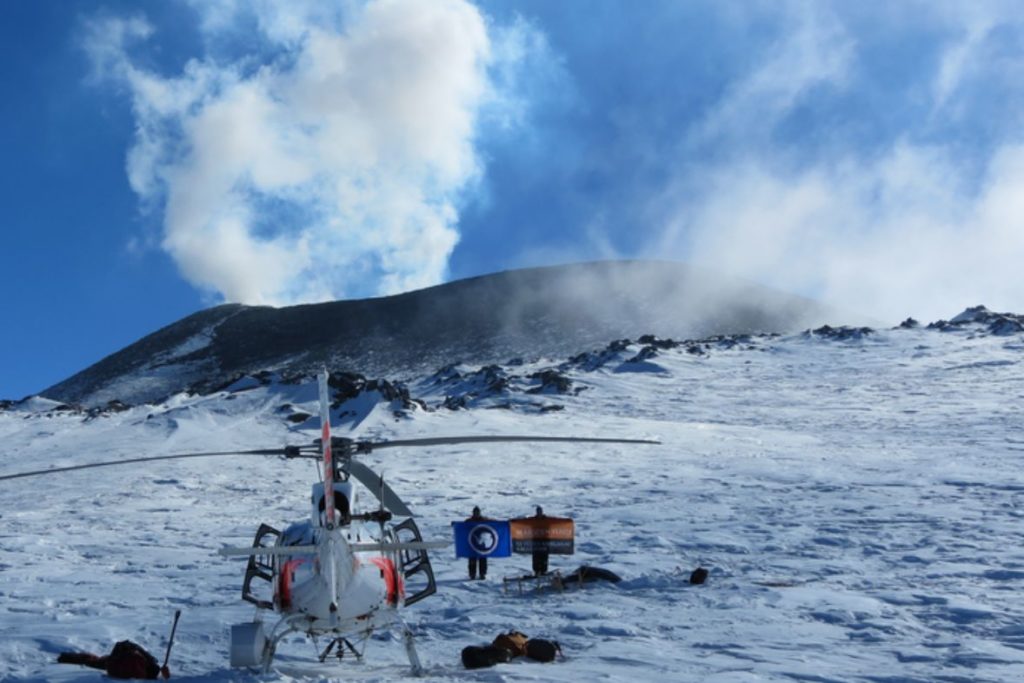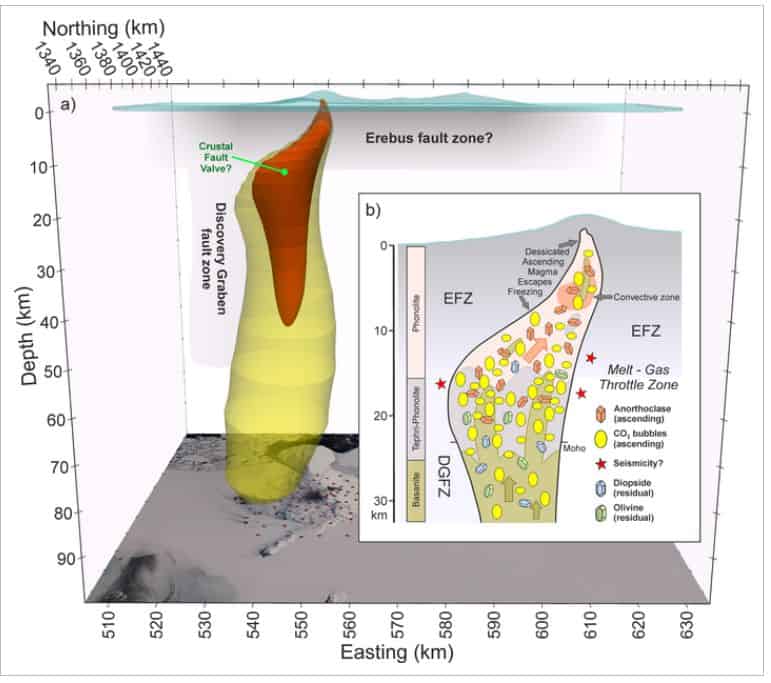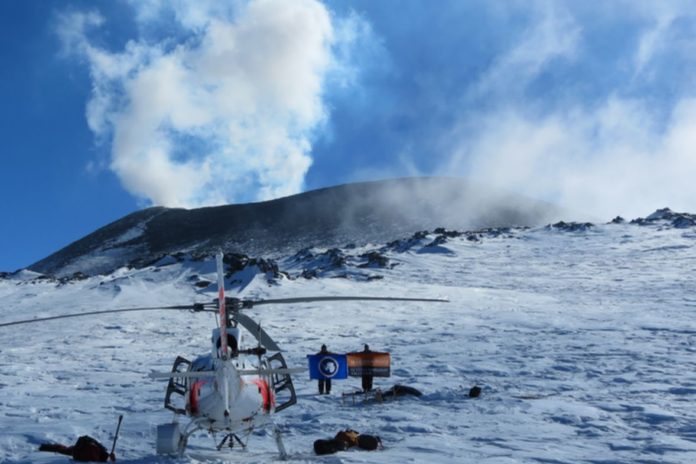Antarctica has long been a realm of mystery and daring exploits made famous by the explorations of James Ross, Roald Amundsen, Robert Scott, and Ernest Shackleton. Antarctica gives examples that illustrate the spectrum of Earth’s volcanic processes, making it an important piece of the puzzle for understanding worldwide continental evolution. A new study from the University of Utah and the University of Canterbury in New Zealand demonstrates how CO2 deep underground aids magma in escaping deep within the Earth and reaching and pooling at the top.
“Mount Erebus is an example of a CO2-dominated rift volcano, a complement to the more widely known arc volcanoes of the Pacific Rim and elsewhere, dominated by H2O,” says Graham Hill, the study’s principal author and co-investigator from New Zealand.
“Understanding both H2O and CO2 volcanoes is important for calculating the budget of such volatile gases deep in the earth that involves the injection of material into Earth’s mantle and its return to the surface to start all over again,” Wannamaker explains.

Phil Wannamaker, the study’s second author and Hill collaborated on the research with University of Utah alumni John Stodt and Michal Kordy, as well as associate scientist Virginie Maris; geophysicists Paul Bedrosian of the USGS, Martyn Unsworth of the University of Alberta, and Yasuo Ogawa of Tokyo Institute of Technology; and senior volcanologist Phil Kyle of the New Mexico Institute of Mining and Technology. Erin Wallin of the University of Hawaii and mountaineer Danny Uhlmann, who is now studying geology at the University of Lausanne, were also coauthors.
Other Volcanoes
The only active volcano in Antarctica is Mount Erebus. Sir James Ross’s expedition ships, which discovered it and the Transantarctic Mountains in 1841, were named after it and its dormant companion volcano, Mount Terror. Sir Ernest Shackleton and his group became the first to climb Mount Erebus in 1908.
Erebus is representative of a group of volcanoes with an alkalic chemical composition, with lavas rich in sodium, potassium, and other components such as rare earth elements but low in silica.
Alkalic volcanoes differ significantly from volcanoes found in the Cascade Range, which stretches from northern California to Alaska. The Cascades is located in an area where the Earth’s tectonic plates are colliding, forcing the ocean’s crust beneath the continent’s crust. As the ocean crust lowers into the Earth and partially melts, the water in the rocks becomes a component of the melt and is the predominant “volatile,” or molecule that quickly exsolves or bubbles out of a solution like carbonation from a fizzy beverage.

This growing magma climbs through and through the crust but seldom reaches the surface because, when the pressure from the underlying crust decreases with ascent, the water bursts out, sometimes explosively, as was the case with Mount St. Helens in 1980 and Mount Lassen in 1912. At a depth of roughly three miles, the remaining magma stalls and freezes in place (five kilometers).
However, the Erebus volcano on Antarctica’s Ross Island is located in a continental rift zone. Continental rifting occurs when the Earth’s crust and mantle are separated. A rift zone can be found in western Utah. It is progressively stretching east-west along the eastern edge of the actively rifting Great Basin geological province. Erebus is located on the edge of the West Antarctic Rift System, which dates back tens of millions of years and is still active today.
Volatiles from the recycling of ocean crust and sediments are also present in rift zone magmas, but they are considerably older and are free to the surface by the rifting process. The volatiles in these magmas is dominated by CO2 rather than water.
A permanent lava lake is another feature of Erebus, which is typical of a developed, CO2-rich rift volcano. However, lava lakes, such as those seen at the Nyiragongo volcano in East Africa and elsewhere, are not found in arc volcanoes such as the Cascades, implying that there must be something about rift volcanoes that allows magma to reach the surface in a reasonably calm manner.
Imagining Magma in the Earth
Researchers can’t easily get rock samples from more than a few kilometers below the surface, so they use geophysical methods to figure out what’s going on at greater depths. It’s like body CT scanning. Seismic imaging, in which sound waves are employed for internal imaging, is the most extensively used and well-known geophysical technology. This is commonly used in oil and gas exploration, for example. Natural seismic sources that can reach deep into the Earth, on the other hand, are scarce near Erebus volcano, and pictures obtained from them have only reached shallow depths.
They employed magnetotelluric sounding. The method of magnetotelluric sounding makes use of the naturally occurring electromagnetic waves that are produced by the sun and by lightning. The majority of such waves pass through the air, but a percentage penetrate the Earth, scatter off interesting rock structures, and return to the surface, where we can measure them” using sophisticated “volt meters”, according to Wannamaker.
Electromagnetic waves travel quicker or slower through the Earth’s interior depending on how well rock and other materials conduct or resist electricity. Because magma is conductive, it may be identified using this method.
Wannamaker’s crew isn’t making its first trip to the Antarctic for geophysical research. They pioneered the technique of high-fidelity magnetotelluric measurements on polar ice sheets with U alum and co-author Dr. John Stodt. Wannamaker led a multi-season campaign over the Central Transantarctic Mountains, illustrating how those mountains were uplifted, in addition to research in Central West Antarctica and at the South Pole. Other researchers in the Arctic and Antarctic polar areas are already using their technique.
Wannamaker and colleagues took measurements at 129 magnetotelluric locations over Erebus’ Ross Island from 2014 to 2017. A computer program then combined the patterns of backscattered electromagnetic radiation from all of the stations to construct an image of Earth’s crust and upper mantle through the island and volcano to a depth of around 60 miles (100 kilometers).
The magma source, according to their magnetotelluric data, is a steep conduit with low electrical resistivity that originates in the upper mantle. However, before reaching shallower magmatic storage and the summit lava lake, the conduit makes a sharp lateral turn in the deep crust. Wannamaker explains, “We interpret the lateral turn to represent a structural ‘fault-valve’ controlling the episodic flow of magma and CO2 gases, which replenish and heat the high-level phonolite magma evolution chamber.” Erebus’ magma produces phonolite, a type of rock.
This magmatic valve is probably made by the intersection of north-south and east-west faults since east-west faults are known to exist in the area around Erebus. It allows magma to rise to the surface.
Unlike the H2O-rich arc volcanoes of the Cascades and Pacific Rim, the CO2-dominated Erebus reveals the structures that allow magma to rise directly to the volcano’s lava lake, unlike water-dominated magmas that halt in the crust.
”Understanding transport controls and pathways for this type of volcano, dominated by CO2, reveals to us the scales and volumes of volatile transport in the Earth,” Wannamaker adds. “Such volcanoes elsewhere are important hosts for essential mineral deposits such as rare earths, increasingly important for societies future resource needs.”
Image Credit: Phil Wannamaker
You were reading: New Research Reveals The Mystery Of Mount Erebus’ Lava Lakes
